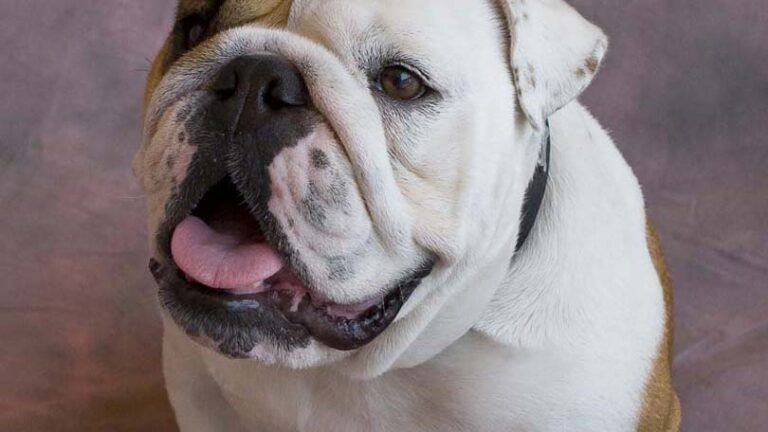Disciplining a Puppy
Watching a litter of pups interact is better entertainment than anything you can find on TV – guaranteed. They play, sleep, and eat as one furry pack and, within that group, they speak a language humans do not always understand. Play bows, chasing and being chased, growling, barking, yipping, biting, pawing, ear position, facial expressions, and tail positions are all forms of non-verbal communication. As dog owners, guardians, breeders, and trainers, the sooner we learn this language, the better our ability to communicate with our four-legged friends will become, making living under the same roof far more pleasant.
Watch a litter of five-week-old pups interact with their mother for example. The mother teaches the pups how to accept discipline by controlling the litter with nudges and body blocks, breaking up heated arguments between littermates, and if the pups get too pushy, turning and walking away. If a pup does something bad like biting her too hard or barking obnoxiously, she ever so gently grips his muzzle between her teeth and he instantly stops what he is doing.
Between the littermates, a hierarchy develops from a very early age. The bigger pups may be the ones to get the most amount of milk but they are not always the dominant within the litter. The ‘runt’ is often the most independent, most confident and most irrepressible of the litter – to survive when you are half the weight of your littermates takes an intestinal fortitude or ‘guts’ that often the big, well fed pups to do not possess. So how does the smaller pup teach or discipline the bigger littermates? By fighting for one thing – runts are usually great scrappers and even then they are out matched and pinned to the ground, they continue to fight from underneath the bigger pup. Once they get away from the bigger pup, they will often come back for more – irrepressible and determined to push any advantage possible.
What about biting? Pups love to bite each other and often will grab a hunk of skin and pull, shake and twist it until the other pup screams in protest. This is how they teach each other how hard to bite during play. The biter with the mouth full of his sibling should let go once the bite-ee screams loud enough.
By watching the litter, you can quickly get a handle on which pup would be easy to train and accept punishment well and which ones may be more then you want to take on. The pup that does not release his bite when his littermate is screaming is going to be a challenge to train – he likes being the boss and is not worried about challenging the other pups.
First time owners often think the runt will be the easy one because it is smaller, not realizing that for that pup to flourish, they had to learn to outmatch the bigger dogs. First time owners often assume that the biggest puppy in the litter will be the most difficult to raise and that is not usually the case. The big puppies tend to be more laid back and easy to train because they have not had to fight to survive. Think about it in breed terms – Chihuahuas have attitudes that far outsize their diminutive stature and can be difficult little dogs to live with. Meanwhile, Great Danes and Mastiffs tend to be mellow couch potatoes. Little dog syndrome is a major consideration when picking a pup!
Depending on what you want to do with your pup and your experience as a dog handler, the runt may be the perfect choice for you. The feisty dogs are usually the ones with the highest level of drive and can make great canine athletes or working dogs. Think of the police dog – how confident does a dog have to be to chase down a criminal and attack? Would a bigger, easygoing pup be a good choice as a future police dog or a little pup that is used to struggling for every morsel of food?
Watch the litter and ask yourself honestly what kind of dog do you want to have for the next ten to twenty years – one that is laid back and easy to train or one that enjoys being the underdog? Or someplace between the two extremes maybe? No matter which one you choose, what you learn by watching the pack is paramount to learning how to best discipline your new pup.
The weeks go by and you finally have your new puppy at home, but you quickly realize that you still feel lost in how best to discipline your pup. There is a fine line between bringing out the best in your pup and squashing their innate nature. First time owners are often either too lenient and do not teach the puppy boundaries at a young age or they are too aggressive or dominant and the pup becomes nervous, leading to overcompensating in their desire to please their new people.
So how do you discipline your puppy? Take some lessons from watching Mom with the litter, how your puppy interacted with its littermates and your own common sense on how to raise a happy, well-adjusted pup!
First, Mom disciplines her pups using a few basic tools.
Grabbing the muzzle is easy for a human to replicate and it works to contain the pup when they are out of control such as nipping at pant legs, chasing the cat or just out of control and hyperactive. Scoop the pup up with one arm while you place the other hand gently but firmly over the pup’s muzzle. The pup should calm down instantly and if he does not, hold him like this until he stops struggling.
Probably the single most effective way to teach a pup good manners is by walking away from it when it is acting up. None of us likes to be ignored; dogs are no different. If a pup is acting out of control or obnoxious, Mom walks away and lets him work it out all on his own. It is a clear message – learn the rules and smarten the heck up, baby!
What if us humans do the same style of training? A misbehaving puppy that refuses to listen is ignored until he learns to behave. Could there be anything easier? Obviously, it is not as simple as it sounds but it is effective when used properly.
Now try some of the behaviors you learned from watching the litter play – yipping when the pup bites too hard, ignoring the pup when it is out of control and pinning the pup to show dominance. All of these effective training methods speak to even a young pup and help develop ‘manners’ in your new charge.
Puppies love to bite or nibble on their humans much as they do with their littermates. However, we do not have the furry covering to protect our delicate skin and as the pup develops, getting a handle on that biting is paramount to having a well-mannered dog that you can take anywhere with no fear of a ‘play bite’ upsetting someone. An effective way to stop that biting is by emulating his littermates – every time his teeth touch your skin, ‘yipe’ loudly. He will stop, look at you and either apologizes by licking somewhere near the spot or bite again but more gently, in which case, you would ‘yipe’ again.
When he does stop biting, offer him a toy to chew on and when he takes it, tell him he is a ‘good puppy’, congratulating him for being so smart! Most puppy owners get into the groove of saying ‘no’ and it is often the first word a pup will learn but if we never tell them when they are doing something right, we are only training them to half their potential.
‘Pinning’ a pup is an effective and clear way to teach the pup who is the real boss in your pack. In fact, it is so effective that every family member should pin the pup for even a few minutes each day. Pinning is simple in theory but a wriggling pup can be hard to get a hold of and never, ever release the pup until it submits and relaxes. If he puts up enough of a fuss so that his owners to release him, guess who wins in his puppy mind? That‘s right – he does and suddenly you have a pup who thinks he is the boss. Keep him pinned until he gives up the struggle and looks away – the universal puppy sign for ‘uncle’. Many trainers recommend doing this for thirty minutes each day, while watching TV or part of your yoga stretches, to reinforce which one of you is the boss. Soon he will learn that being dominated in this fashion is normal and submitting to it is the easiest path.
Discipline never includes hitting, spanking, harsh corrections with a leash or any other ‘negative’ training method while being overindulgent creates an ill-mannered furry demon that becomes a nuisance rather then part of the family. It is never too early to begin using these positive disciplining methods and the result will be a controlled, confident and well-mannered adult dog in other word, the ideal companion!

Having discovered a fondness for insects while pursuing her degree in Biology, Randi Jones was quite bugged to know that people usually dismissed these little creatures as “creepy-crawlies”.







